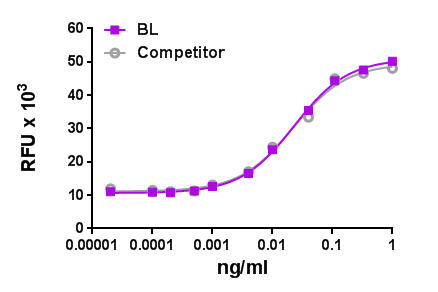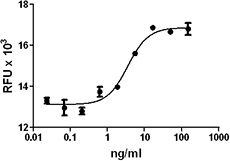- Regulatory Status
- RUO
- Other Names
- B cell growth factor 1 (BCGF-1), B-cell stimulatory factor 1 (BSF-1), Interleukin-4, lymphocyte stimulatory factor 1, MGC79402
- Ave. Rating
- Submit a Review
- Product Citations
- publications
| Cat # | Size | Price | Quantity Check Availability | Save | ||
|---|---|---|---|---|---|---|
| 714904 | 20 µg | £174 | ||||
This product is not available for shipping outside of the United States.
IL-4 is the primary cytokine implicated in the development of Th2-mediated responses, which is associated with allergy and asthma. The type I receptor comprises IL-4Rα and the common gamma-chain (γc), which is also shared by the cytokines IL-2, -7, -9, -15 and -21 and is present in hematopoietic cells. IL-4 can use the type II complex, comprising IL-4Rα and IL-13Rα1, which is present in non-hematopoietic cells. This second receptor complex is a functional receptor for IL-13, which shares approximately 25% homology with IL-4. The type I receptor complex can be formed only by IL-4 and is active in Th2 development. In contrast, the type II receptor complex formed by either IL-4 or IL-13 is more active during airway hypersensitivity and mucus secretion and is not found in T cells.
Product DetailsProduct Details
- Source
- Human IL-4, amino acids His25-Ser153 (Accession# NM_000589), was expressed in E. coli.
- Molecular Mass
- The 130 amino acid N-terminal methionylated recombinant protein has a predicted molecular mass of 15.1 kD. The predicted N-terminal amino acid is Met.
- Purity
- >98%, as determined by Coomassie stained SDS-PAGE and HPLC analysis.
- Formulation
- Lyophilized, carrier-free.
- Endotoxin Level
- Less than 0.1 ng per µg of protein.
- Storage & Handling
- Unopened vial can be stored at -20°C or -70°C. For maximum results, quick spin vial prior to opening. Reconstitute in water to a concentration of 0.1-1.0 mg/ml. Do not vortex. It is recommended to further dilute in a buffer, such as 5% Trehalose, and store working aliquots at -20°C to -80°C. Avoid repeated freeze/thaw cycles.
- Activity
- ED50 is ≤ 0.2 ng/ml, corresponding to a specific activity of ≥ 5.0 x 106 units/mg as determined by the dose-dependent stimulation of the proliferation of human TF-1 cells.
- Application
-
Bioassay
- Product Citations
-
Antigen Details
- Structure
- Cytokine
- Distribution
- IL-4 is produced by Th2 cells, naive CD4+ T cells, NKT cells, and basophils.
- Function
- IL-4 plays a crucial role in the differentiation of Th2 cells and induction of Th2 associated cytokines. IL-4, through its activation of STAT6, upregulates GATA3 expression and also suppresses Th1 and Th17 cell responses, partly through the upregulation of growth factor independent 1 (GFI1), a transcriptional repressor of IFN-γ and IL-17 production. IL-4 induces macrophage activation and TSLP production. IL-4 recruits and activates IgE-producing B cells (IgE class switching) and enhances IgE-mediated responses by up-regulating IgE receptors on B lymphocytes, mast cells, and basophils. In addition, IL-4 also induces VCAM-1 on vascular endothelium and thus directs the migration of T cells, monocytes, basophils, and eosinophils to the inflammation site.
- Interaction
- T cells, B cells, macrophages, epithelial cells, smooth muscle cells, and bronchial fibroblasts.
- Ligand/Receptor
- IL-4 signals through type I (IL-4Rα, γc) and type II receptor (IL-4Rα, IL-13Rα1) complexes.
- Cell Type
- Hematopoietic stem and progenitors, Embryonic Stem Cells
- Biology Area
- Cell Biology, Stem Cells, Immunology
- Molecular Family
- Cytokines/Chemokines
- Antigen References
-
1. Swain SL, et al. 1990. J. Immunol. 145:3796.
2. Hsieh CS, et al. 1992. P. Natl. Acad. Sci. USA 89:6065.
3. Allison-Lynn A, et al. 2006. J. Immunol. 176:7456.
4. Kato A, et al. 2007. J. Immunol. 179:1080.
5. LaPorte SL, et al. 2008. Cell 132:259.
6. Martinez FO, et al. 2009. Annu. Rev. Immunol. 27:451. - Gene ID
- 3565 View all products for this Gene ID
- UniProt
- View information about IL-4 on UniProt.org
Related FAQs
- Why choose BioLegend recombinant proteins?
-
• Each lot of product is quality-tested for bioactivity as indicated on the data sheet.
• Greater than 95% Purity or higher, tested on every lot of product.
• 100% Satisfaction Guarantee for quality performance, stability, and consistency.
• Ready-to-use liquid format saves time and reduces challenges associated with reconstitution.
• Bulk and customization available. Contact us.
• Learn more about our Recombinant Proteins. - How does the activity of your recombinant proteins compare to competitors?
-
We quality control each and every lot of recombinant protein. Not only do we check its bioactivity, but we also compare it against other commercially available recombinant proteins. We make sure each recombinant protein’s activity is at least as good as or better than the competition’s. In order to provide you with the best possible product, we ensure that our testing process is rigorous and thorough. If you’re curious and eager to make the switch to BioLegend recombinants, contact your sales representative today!
- What is the specific activity or ED50 of my recombinant protein?
-
The specific activity range of the protein is indicated on the product datasheets. Because the exact activity values on a per unit basis can largely fluctuate depending on a number of factors, including the nature of the assay, cell density, age of cells/passage number, culture media used, and end user technique, the specific activity is best defined as a range and we guarantee the specific activity of all our lots will be within the range indicated on the datasheet. Please note this only applies to recombinants labeled for use in bioassays. ELISA standard recombinant proteins are not recommended for bioassay usage as they are not tested for these applications.
- Have your recombinants been tested for stability?
-
Our testing shows that the recombinant proteins are able to withstand room temperature for a week without losing activity. In addition the recombinant proteins were also found to withstand four cycles of freeze and thaw without losing activity.
- Does specific activity of a recombinant protein vary between lots?
-
Specific activity will vary for each lot and for the type of experiment that is done to validate it, but all passed lots will have activity within the established ED50 range for the product and we guarantee that our products will have lot-to-lot consistency. Please conduct an experiment-specific validation to find the optimal ED50 for your system.
- How do you convert activity as an ED50 in ng/ml to a specific activity in Units/mg?
-
Use formula Specific activity (Units/mg) = 10^6/ ED50 (ng/mL)

 Login / Register
Login / Register 











Follow Us